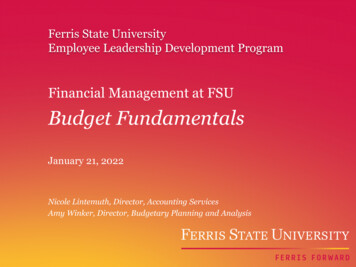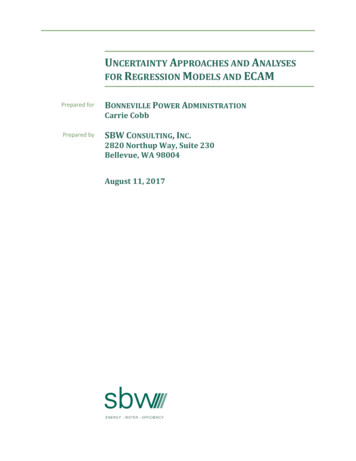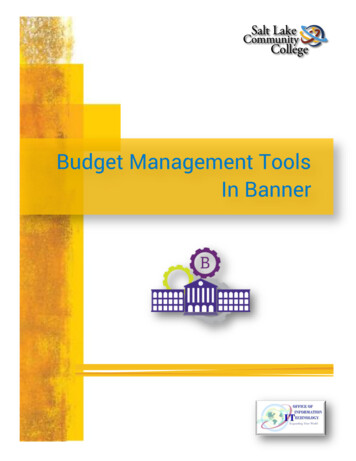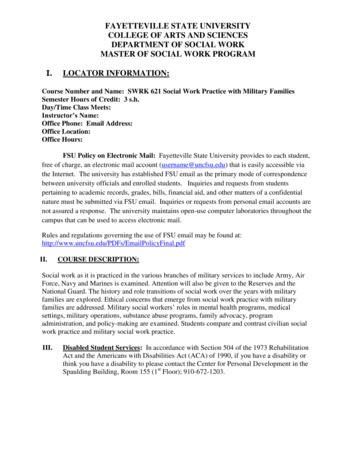
Transcription
Ferris State UniversityEmployee Leadership Development ProgramFinancial Management at FSUBudget FundamentalsJanuary 21, 2022Nicole Lintemuth, Director, Accounting ServicesAmy Winker, Director, Budgetary Planning and Analysis
Session Overview Budgeting Concepts Fiscal Management FSU Budget Fundamentals Current Budget Overview2
What is a Budget? Plan– Roadmap for the future Control– Monitored - spending is curtailed when needed Commitment– Promise to deliver services, employ people, etc. Performance Measure– Assessing performance on deliverables3
Planning and Budgeting Processes are directly linked– Plans influence budgets– Budgets influence plans Dynamic activities– Internal and external forces influence planningand budgeting on an ongoing basis Statement of businesses priorities– Resources reallocated from low- to highpriority needs4
The Ferris Budget Planning Model Ferris’ budget model is a planning functionreporting directly to the President. The model encompasses four basic fiscal functions:– Budget Development (Planning) Short-term (annual) budget development Long-term (four-year) budget planning– Budget Allocation and Analysis– Fiscal Control of the allocated resources Responsibility of Finance Office Provides checks and balances– Audit (GASB) Responsibility of the Finance Office5
Who’s Involved? Planning and Budgeting must be directedfrom the top– CEO/President/Governing Board– Strategic Plan Widespread Involvement– Strategic Planning and Resource Council(SPARC), Tuition and Student FeesCommittee– Individuals (experts in their areas),University VP’s, Deans, Managers, etc.6
How are Budgets Developed? Prior Experience is used to Project the Future– Annual financial statements– Prior year budget is compared to actual results– Generally incremental in nature Based upon Planning Assumptions– Projected Revenues and Expenses Sources of revenue– Tuition and State Funding Anticipated changes– Enrollment/New Initiatives/External Support7
Budget Assumptions8
Ferris Budget Components Revenues– State Appropriations– Tuition and Fees– Departmental Revenue Expenses– Salaries/Benefits– Supply & Expense– Utilities– Debt Service– Student Aid9
Operational (Base) vs One-Time Budgets Operational (Base) budgets include annual,recurring categories of revenue and expenses– Positions, scholarships, supplies, utilities, etc. One-Time budgets are temporary– Once it’s gone, it’s gone!– Classroom remodel, construction projects, department carryover10
Questions on Budgeting Concepts?
Fiscal ManagementGuiding Principles: Financial responsibility Laws and policies Internal ControlsReporting: The Board of Trustees The State Other agencies12
Financial Responsibility Who does Ferris have a responsibility to?– Federal and State government, taxpayers,students, granting agencies, donors, employees,vendors, public, etc. Key responsibilities– Financial integrity, due care, loyalty, good faith,full and fair disclosure13
Laws & Procedures The gambit of governmental regulatory agencies– IRS, DOL (FLSA), OSHA, EPA, many more www.federalregister.gov/agencies (432 federal agencies) www.Michigan.gov/som/0,1607,7-192-29701 29702 30045--,00.html (18 state agencies) Budget Management Policy Business & Special Expense Policy Travel & Expense Policy14
Internal Controls Definition:– Systematic measures to conduct business in an orderly andefficient manner; safeguard its assets and resources; deter anddetect errors, fraud, and theft; ensure accuracy andcompleteness of its accounting data; provide reliable and timelyfinancial and management information; and ensure adherenceto its policies and plans.www.business dictionary.com What are some examples?– Separation of duties, limiting access, requiring approvals,budget to actual reconciliations, locking your office/computer,etc. Who do internal controls protect?– The University– Employees– Stakeholders15
Budget Controls16
Reporting Financial Statements - www.ferris.edu/finance– Balance Sheet– Income Statement Board Reports– Budget to Actual reports– Internal Audit reports IPEDS, HEIDI, ACFR, etc.17
Key Fiscal Analysis Tools Constant analysis of the fiscal health of anorganization is crucial to success– Monthly budget comparisons How we are performing compared to budget– Annual financial statements Comparison over time compared to prior years– Assessment of how budget supports mission/goals Progress on strategic planning goals18
Questions on Fiscal Management?
FSU Budget Fundamentals Ferris is a major industry––––Customer base of 10,361 studentsJust over 1,025 full-time employeesAnnual operating revenue of 196 millionFerris has an annual payroll of over 136 million Ferris is the largest employer in Mecosta County– Locations across the State20
Where does Ferris’ Money Come From? State of Michigan– FSU is a public university, supported in part throughState budgets State operating appropriation State capital appropriation Students– Tuition and Room/Board– Books and Supplies Public– Grants, Contracts, Gifts– Consumers of products and services (golf course, etc.)21
FSU Operating Funds General Fund– Primary support from State of Michigan and studenttuition; supports the academic mission of the University Designated Fund– Supported from gifts and grants for designated purposes Auxiliary Fund– Self-supporting operations of the University (housing,dining, golf course, etc.) Expendable Restricted Fund– Restricted state and federal grants and contracts22
FSU Non-Operating Funds Student Loan Fund– Provides students with the means to help meet theirfinancial obligations in obtaining their education. Majorsources of revenue are private gifts and governmentgrants. Endowment Fund– Amounts for which the donor or Board of Trustees hasspecified that the principal may not be expended. Interestincome is used to support operations. Pension Obligation Fund– GASB 68 and 7523
FSU Non-Operating Funds – cont. Plant Fund - consists of four units– Unexpended Appropriations - records assets available fornew construction or major repairs/renovations– Reserve for Maintenance and Replacement– Reserve for Debt Service– Physical Properties - value of physical properties Agency Fund– Represents funds held in custody for students andUniversity related organizations Residence Hall Association24
Operating Fund RevenuesFY 2021 Actual - 287 Million(Amounts in Millions)DesignatedFund, 14Auxiliary Fund, 25General Fund, 203ExpendableRestricted Fund, 45General Fund25Designated FundAuxiliary FundExpendable Restricted Fund
General Fund ExpendituresFY 2021 Actual - 198M(Amounts in Millions)Student Services, 15.6, 8%Instruction andAcademic Support, 108.4, 55%Plant, 13.3, 7%Institutional Support, 17.2, 8%Transfers, 17.3, 9%Instruction and Academic SupportInstitutional SupportTransfers26Financial Aid, 25.4, 13%Student ServicesResearch and Public ServiceResearch and PublicService, 0.4, 0%PlantFinancial Aid
Questions on FSU BudgetFundamentals?
State of Michigan BudgetFY 2021 - 61.6 BillionExcludes Interdepartmental GrantsSchool Aid 15.5Transportation 5.1Corrections 2.1HigherEducation 1.5CommunityColleges 0.7All Other 8.3Health and HumanServices 28.528
Michigan Public Universities 15 Public Higher Education Universities inMichigan All are impacted by State of Michigan budgets– Receive State Appropriations– Must follow state guidelines when setting tuitionrates The State of Michigan fiscal year is differentthan FSU’s fiscal year– State of Michigan: October 1– Ferris State University: July 1 Timing of the State budget approval impacts ourability to build balanced budgets in a timelymanner29
State Appropriation ProcessUniversityBudgetSubmission NovemberStateFiscal YearBegins –October 1State of MI Fiscal Yearbegins October 1FSU Fiscal Yearbegins July 1BudgetFinalized –June or as lateas Oct 130Governor’sState of theState JanuaryGovernor’sBudget FebruaryLegislativeResponses –March - May
University Operating Appropriations2019-2020 1.5 Billion(Amounts in Millions)GVS, 73.5FSU, 55.9LSS, 15.3MSU, 288.9EMU, 77.6MTU, 50.8CMU, 89.6NMU, 48.9WSU, 112.4OAK, 53.4SVS, 30.8UMA, 322.9WMU, 203.5UMF, 24.031UMD, 26.3
FSU State Appropriation HistoryFinancial Statement Amounts – Base Appropriations in MillionsFY 02FY 03FY 04FY 05FY 06FY 07FY 07 PaidFY 08FY 08 PaidFY 09FY 10FY 11FY 12FY 13FY 14FY 15FY 16FY 17FY 18FY 19FY 20FY 21FY 2232 55.5 55.5 50.0 49.0 48.6 50.0 43.9 49.7 54.3 50.2 48.6 48.6 41.3 44.3 45.6 49.1 50.2 52.3 53.6 55.0 56.0 55.9 58.7
State Appropriation Instability Changes since 2002:– 2002 to 2012: 10-year annual state appropriation reduction of 14.2 million (-25.6%)– 2002 to 2012: 10-year cumulative change in US inflation was 27.62%– 2002 to 2022: 20-year annual state appropriation increase of 3.2 million (5.7%)– 2002 to 2021: 19-year cumulative change in US inflation was 52.5%– Mid-Year FY 2007 6.1M (12.5% of the FY 07 total) was delayed or eliminated All but 844k was later repaid in FY08–FY 2012 15% decrease from 2011 – largest one year decrease in history Lowest appropriation since 1992– FY20 state appropriation surpassed the 2002 level for first time– State appropriations currently support 30% of FSU’s General Fund budget– The rate of state increases have not kept pace with US inflation rates– When tuition revenue doesn’t grow enough to replace declining appropriations, reductionsmust be made to achieve a balanced budget33
FSU General Fund RevenuePerspectiveState68%FSU - 1980AllOther3%34Tuition29%State30%FSU - 2022AllOther1%Tuition69%
10-Year Tuition IncreaseResident, Undergraduate, Lower Division - 30 Annual Credits 9,000 9,480 9,930 11,760 11,190 11,460 10,950 10,440 10,710 12,180 13,290 13,650 12,930 12,63030.7% Increase from 2012 to 2022Average Increase of 2.9% per yearFY 0935FY 10FY 11FY 12FY 13FY 14FY 15FY16FY17FY18FY 19FY 20FY 21FY 22
Michigan Public UniversitiesChange in Cost of Attendance – Resident, On-Campus2008-09 to .5%39.5%WMUUMAGVSU42.9%43.1%MTULSSU44.7%44.8%UMD Average55.1%55.2%OAKEMU57.7%46.7%MSUNMUSVSUWSU
Michigan Public UniversitiesChange in Net Price of Attendance - Composite2008-09 to 2019-2047.8%45.5% 46.3%33.7%13.2%11.1% 12.5% 8.3%24.7%21.8% 23.0%WMU Average EMUUMFOAKSVSUUMDNMUWSU
Enrollment - Fiscal Impact Six-Year Enrollment Change of 29.6% between Fall 2015and 2021– 14,715 Fall of 2015; 10,361 Fall of 2021 Tuition revenue declines when enrollment declines When enrollment declines, our practice is to cut thebudget and not increase tuition38
7-282028-292029-302030-312031-32Michigan High School GraduatesNumber of Graduates per YearMichigan Public and Private Schools135,000125,000115,000105,00095,00085,000
Loss of Revenue - Fiscal Impact Base budgets are reduced to match revenues: inputsmust match outputs Five-Year Budget Reductions total 43.6M (223.5 FTE)–––––FY 17 – 24 FTE - 5.2MFY 18 – 9.5 FTE - 3.0MFY 19 – 49 FTE - 7.3MFY 20 – 37 FTE - 8.0MFY 21 – 104 FTE - 20.1M State Appropriation instability40
Planning for the Unexpected41
FSU Budget Today Challenged– Enrollment– State disinvestment Balanced– Representative of the priorities of theUniversity Flexible42
2021-22 FSU General Fund Budget 195.6 Million(Amounts in Millions)RevenueState, 58.7,30%ExpensesOther, 3.0,2%Tuition, 133.9,68%43SalaryandBenefits, 136.7,70%Operations, 37,19%StudentAid, 26.4,13%
Looking ForwardFY 2022-23 Challenges and Goals Stop Enrollment declines and the resulting decline intuition collections Increase revenue to break-even point for Housing, Diningand Auxiliaries At the state level challenges include:– Tuition Incentive Program (TIP) – funding and limits– “Free” community college– Negative perceptions on the value of college– State funding priorities Capital Outlay44
Web Reference This presentation– Most Recent Budget Forum– -Policy.pdfTransportation and Travel pdfBusiness and Special Expense Policy– http://www.ferris.edu/finance/Budget Management Policy– icplan19 24/keystrategictargets.htmFinancial Statements– s.pdfStrategic Plan Goals– r/financial/transportation-travel.pdf
Thank You for your Attention!Questions?
Leadership Exercise
Jan 21, 2022 · Financial Management at FSU. Budget Fundamentals. January 21, 2022. Nicole Lintemuth, Director, Accounting Services. Amy Winker, Director, Budgetary Planning and Analysis. Session Overview Budgeting Concepts Fiscal Management FSU Budget Fu










